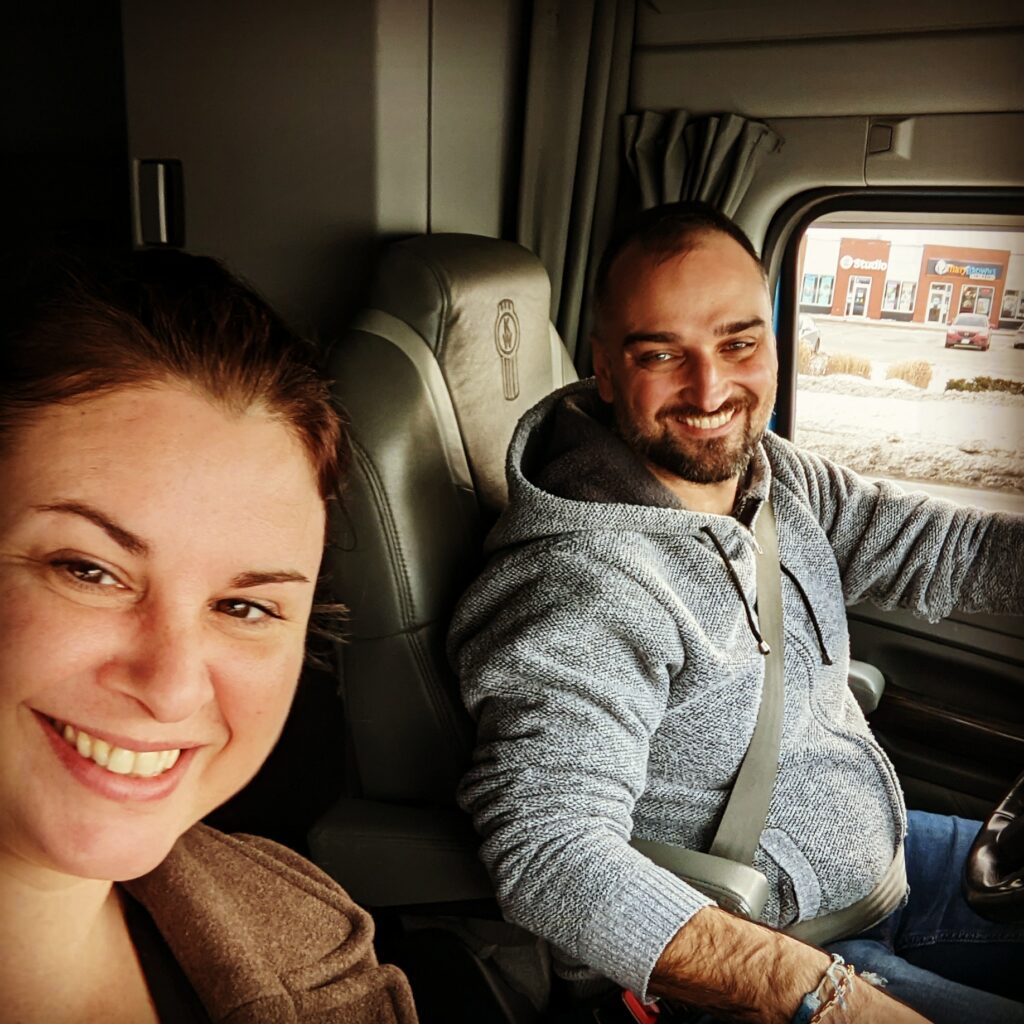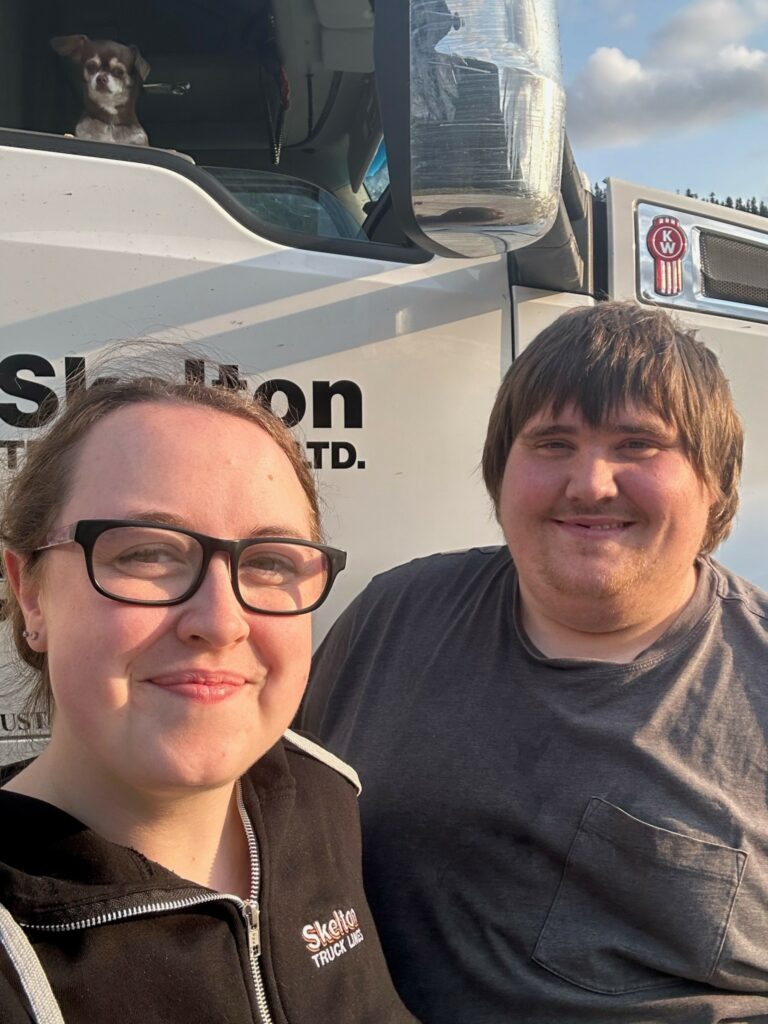Teamwork makes the team driving work
Leah Gorham recalls how her boyfriend and co-driver, Roland Bereczki, once ‘demoted’ her from night shift duty after she accidentally pulled into a mall.
Bereczki has been driving since 2003, and Gorham joined him nearly two years ago, after leaving her nursing career. He was even Gorham’s trainer in 2021, and she jokes he sometimes forgets to turn off his instructor mode. But the dynamic works well for these Boom Transport expedited drivers. Gorham gains experience, and she gets to spend more time traveling with her loved one and their dog.
Team drivers like them make expedited deliveries possible, covering a solo driver’s mileage in a fraction of the time. And most are attracted to the job by its financial benefits, says Jeff Workman, director of western operations at CAT. “Our strong performing teams in the West [are] earning $120,000 or $130,000 [per driver] a year. That’s a tremendous amount of money for driving a tractor. It’s something that a lot of these guys didn’t know would be possible.”

Some CAT team drivers who come from abroad, for example, are able to earn enough money to send home or bring their families to Canada.
In addition to higher pay, teams also benefit from reduced wait times and priority loads, add CAT drivers Baljinder and Dharwinder Singh, of Halifax.
Team driving challenges
But it takes a lot to be a team driver.
Michael Hahn, an owner-operator recruiting specialist at Canada Cartage, reflects on his experience of recruiting and matching teams at Groupe Teams-West, and says many jump into team driving without researching the job requirements and challenges.
He faced his own struggles during a short time as a team driver. “The movement limited my ability to get the proper sleep I required,” Hahn says, adding that a driver who sleeps poorly for a couple of nights in a row can become a danger.
There are personal dynamics to manage, too.
To avoid conflicts on the road, some fleets like Bison Transport exclusively hire established teams. And Hahn says this makes sense: in his experience, established teams understand each other’s needs, workflows and habits.
CAT, however, has successfully matched drivers into new teams, Workman says. While some must be re-matched, it’s an exception rather than a rule.
“Usually, [if] drivers have been put together it’s for a good reason.”
Pairing like-minded drivers
The key is to pair like-minded drivers, he says. To ensure a good match, CAT considers hobbies, personality traits, views, and cultural backgrounds. For example, smokers would not be matched with non-smokers, while drivers with the same first language would be paired.
Being able to communicate fluently is crucial, especially safety-wise, says CAT driver Baljinder, adding that the most important qualities for a team driver are compassion and willingness to understand co-workers. Even childhood best friends like them have misunderstandings.
“Sometimes we’ll crack a joke on each other and one gets aggressive. It happens sometimes. But we understand each other so we know [one of us] is going through a bad day,” says his co-driver, Dharwinder. “And we try to help.”

Matching lifestyles, building trust
Things might work out differently with drivers who don’t have pre-existing friendships.
Hahn has heard stories about drivers being sent home mid-trip on a bus, simply because they weren’t able to co-exist with their partners.
Workman has seen a few teams fall apart when one driver didn’t drive as much as their counterpart. “Maybe that person stopped two or three times for coffee, or they’ve stopped for lunch and just prevented that truck from earning the full miles. So basically, [it’s] one teammate not pulling their weight.”
It’s why matching lifestyles and family backgrounds is also important, Hahn says. While one might be willing to pick up a longer trip, the other might need to be back home for a child’s birthday. Not being able to agree on one extra trip makes a difference in payroll.
Trust is another factor, crucial to a driver’s ability to sleep soundly on the road. This was a challenge for Bereczki at first. Even though he trained Gorham, it was hard to share trips with a less-experienced driver after years of running solo. “You overcome it slowly, and sleep like a rabbit – one eye shut, one eye open,” he jokes.
Finding a balance
In general, they find a balance. Roland encourages her to claim her right of way, playfully calling her “too Canadian” for being courteous, teaching her to drive more assertively, yet safely. When Leah is in the passenger seat, she acts as an additional set of eyes, reminding Roland of speed limits and alerting him of reckless drivers nearby.
Getting used to a co-driver was also a challenge for Zech Witty, one of the team drivers at Skelton Truck Lines. He and his wife Elizabeth started driving at the same time and he says it took time to build confidence.
“Once we got over that, a few months in the truck, it got way better,” he says.
“You have to completely trust the person [with] your life. So, what we did [was] having blind faith in each other,” Elizabeth says.
“I’m not sure how people who aren’t married do it.”
But Baljinder and Dharwinder say lack of trust was never an issue for them. One of the agreements they have is to never be afraid to ask for help from a friend, senior colleague, or dispatch.

Fleet support
A fleet’s ability to provide constant support and communication to facilitate each move is essential when managing team drivers, says Tracy Clark, director of driver recruitment and retention at Bison Transport. This is where advanced planning comes into play. Organizing round trips, for example, eliminates waiting times and helps drivers with future trips and personal plans.
“We also want to ensure that we’re not creating short trips that force the sleeping drivers to have to wake up,” Clark says.
Clark and Workman say their fleets never had to interfere in conflicts between team drivers. But dispatchers and team managers are skilled to do so, if necessary. For example, lessons from a negotiation course available on Bison’s internal learning platform can be used to defuse tension, should the need arise.
But teams, especially pre-established ones, tend to address conflicts before they get out of hand, say the three teams we interviewed.
Being able to “give and take” is essential, says Zech Witty, emphasizing the need for compromises. For Elizabeth, the main challenge was learning how to live together in a tight space. But the couple found a solution. They go to separate parts of the truck if tensions rise.
“We have a curtain divider in the middle, [so] we’ll take our time,” she says.
She also had to learn to give her husband more personal space. At first, their downtime and hobbies were different. While Zech enjoys watching TV, Elizabeth prefers to spend time together. “I really like to, if I have time, hang out and bug him.”
Off-duty time
Proper communication and understanding help establish the comfort to spend off-duty time together as well.
Gorham and Bereczki, on the other hand, need time apart when they return home to New Brunswick.
“We have to balance it out because we’re together so much. And you can’t forget your friends and your family, and all the things that you like to do,” Gorham says.
She notes that spending some time apart might even be a good idea when working together outside the truck. While renovating the house, for example, the couple goes to different rooms and works on separate tasks.
“I’ll get my piece of the puzzle, and he’ll do his. Because we don’t work well together that way, for some reason. We work well in the truck.”
Establishing routines and dividing tasks can also help. While Gorham manages daytime driving and handles unhappy customers, Bereczki does paperwork and drives at night. Baljinder and Dharwinder alternate driving shifts from 3 a.m. to 3 p.m., switching night and day schedules weekly. Within Zech and Elizabeth’s team, Elizabeth primarily manages paperwork, cooking, and daytime driving.
While these teams might have different dynamics, all three say communication is key. And Bereczki adds that focusing on goals is also crucial. “If you’re not focused on your goals, you’re gonna hate it. It’s a lifestyle. It’s a hard job and it’s a pleasant job. It’s all of the above.”
Have your say
This is a moderated forum. Comments will no longer be published unless they are accompanied by a first and last name and a verifiable email address. (Today's Trucking will not publish or share the email address.) Profane language and content deemed to be libelous, racist, or threatening in nature will not be published under any circumstances.
-
Each driver can $120,000 to $130,000 a year.
i Never see a rate of 120 000 per driver in 33 years so i Guess wrong info or maybe just a candy look to good again
I think the driver split the $130,000 a year that’s how it usually works. If each driver made that kind of money, there would be all kinds of truck drivers out there looking for that job. Thank you.
$120.000 plus each per year? Sounds more like a HR line to get you to sign. Promise diamonds but deliver peanuts.
Running team each driver only makes $60,000.Pretty poor wages for living in a truck in my opinion.